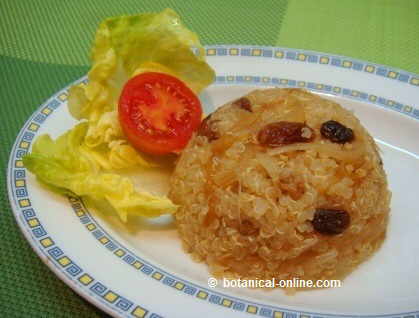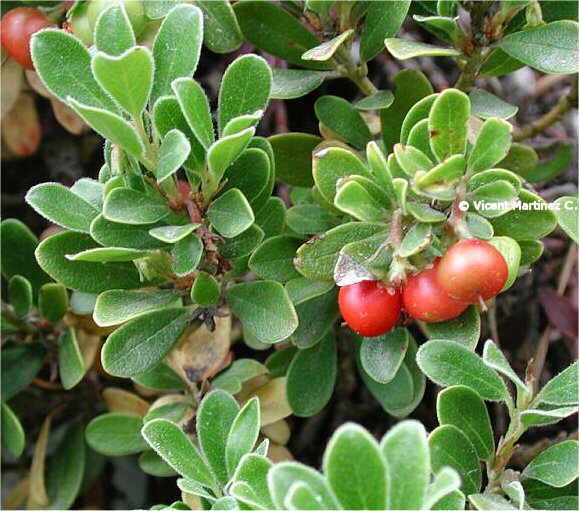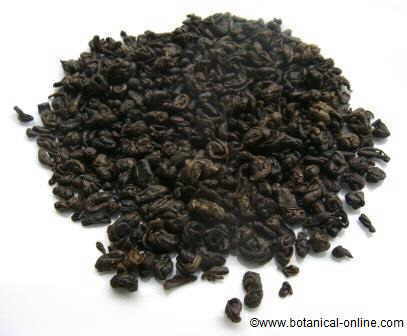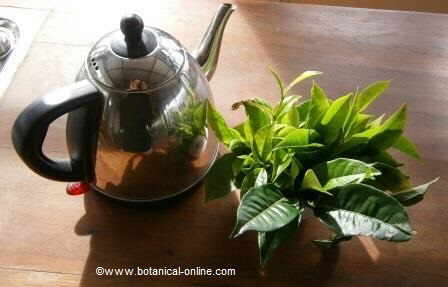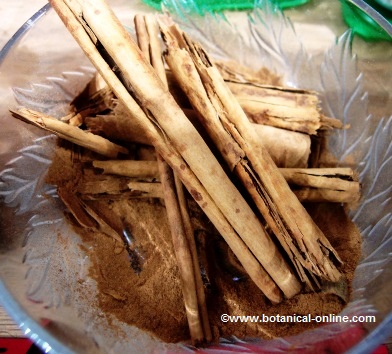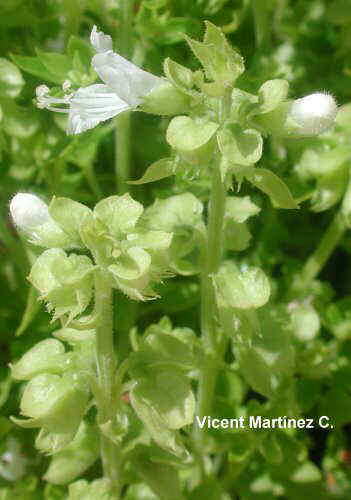Contents
- 1 What is a cinnamon plant?
- 1.1 Characteristics of cinnamon (Cinnamomum verum)
- 1.2 Description of cinnamon:
- 1.3 How is cinnamon obtained?
- 1.4 Components of cinnamon
- 1.5 Traditional uses of cinnamon (History of cinnamon)
- 1.6 Cinnamon from Sri Lanka, ancient Ceylon or “island of spices”
- 1.7 Uses of cinnamon
- 1.8 Other species of cinnamomun
What is a cinnamon plant?
Characteristics of cinnamon (Cinnamomum verum)
Common English name: Cinnamon, Chinese cassia, Chinese cinnamon
Scientific name: (Cinnamomum verum = Cinnamomum zeylanicum).
Etymology: The name of the genus Cinnamomum comes from the Greek “Kinnamomon”. It is believed that it is derived from cina, referring to China, which is where cinnamon was formerly imported; and amomos, which means cardamom , a plant of the ginger family, with a cinnamon-like odor. The name is shared with cinnamon from China (Cinnamomum cassia (L.) D. Don)
Family: Lauraceae or laurel family, such as laurel (Laurus nobilis)
Description of cinnamon:
Cinnamon is an evergreen tree of the laurel family of up to 15 m. tall, though cultivated forms rarely exceed 10 m. Branches very aromatic with a double crust.
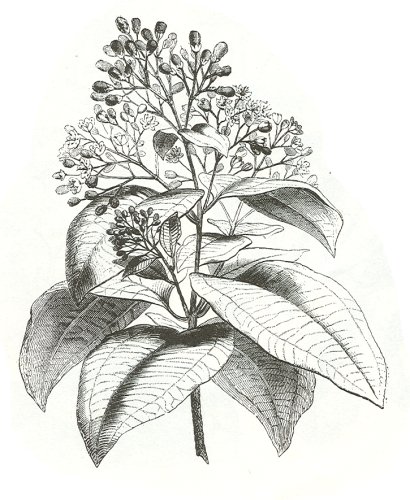
A drawing of the plant
Ovate leaves up to 18 cm in length, with three well-marked nerves, coriaceous, acuminate with the edge smooth and very fragrant. Reddish when young, becoming bright green and pale green underside at maturity.
Smelling flowers in panicles, white or red.
Brown or bluish black fruit, berry, about 1 cm in diameter, very spicy.
Tree coming from the south of India and Sri Lanka, appears cultivated in many warm places of the world.
Conservation of cinnamon: Cinnamon sticks should be stored in tightly closed containers in a cool, dry place under the light.
How is cinnamon obtained?
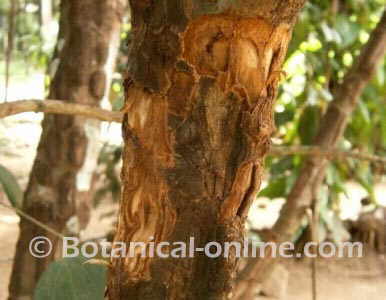
Photo of cinnamon tree trunk where you can see the thick bark or cinnamon spice
Cinnamon may come from different species, although the most recognized is obtained from Cinnamomum verum = Cinnamomum zeylanicum that comes from Sri Lanka. This plant grows wild in Ceylon and other parts of the Moluccas. Today the cultivation of cinnamon is found in many hot countries.
Cinnamon spice, as we know it, comes from the lower crust of Chinese cassia or Chinese cinnamon. (More information on this subject in “Cinnamon as a spice“)
Components of cinnamon
- Acids: ascorbic, palmitic pcoumaric (crust)
- Terpenes: alphapinene, alphaterpinene, alphaylangene, camphene, betapinene, caryophyllene, limonene, Linalool (bark)
- Coumarins (Bark)
- Essential oil, rich in benzalhehyde (Plant) eugenol, farnesol, gammaterpineol, geraniol, isoeugeneol, caryophyllene (bark)
- Furfural (bark)
- Camphor (bark)
- Fiber (bark)
- Tannins (plant)
- Mucilage (bark)
- Sucrose
- Vanilla
- Minerals: boron, calcium, zinc, chlorine, copper, cobalt, chromium, strontium, phosphorus, iron, manganese, nickel, lead, potassium, sodium, iodine (crust)
- Vitamins: Vitamin C, niacin, thiamin.
Traditional uses of cinnamon (History of cinnamon)
The use of cinnamon as a medicinal plant is very old. The ancient Egyptians knew it well, as is apparent in the drawings found in the pyramids. It was imported from China 2000 years BC. People used cinnamon, along with other spices, mainly for embalming their mummies.
In Greece and Rome it was frequently used to improve digestion. It is believed that this species, along with pepper and cardamom, were the first to be used in the Mediterranean area. The geographer and historian Herodotus (484-425 BC) mentions in his writings the use of this spice from Ceylon (Cinnamomum zeylanicum) and that of Chinese cinnamon (Cinnamomum cassia). The Romans used cinnamon in their important ceremonies. It is said that Nero burned all the cinnamon in Rome at the funeral of his wife in the year 65 BC.
Cinnamon is documented several times in the Bible, in the books of Exodus and Proverbs.
In the East the use of this spice is much earlier. In China is documented in the year 2700 BC. In India as a medicinal plant, its use in Ayurvedic medicine is ancient.
The consumption of cinnamon in the West has always been restricted to the wealthier classes were the only ones who could afford the prohibitive price of this spice that was brought from remote places.
During the Middle Ages most of its sales was controlled by the Venetians and Genoese merchants that obtained through the Muslims who controlled the eastern routes.
Cinnamon from Sri Lanka, ancient Ceylon or “island of spices”
In the sixteenth century, the Portuguese discovered Ceylon (now Sri Lanca) and monitored its operation until the mid-seventeenth century when the trade was dominated by the Netherlands.
In the late eighteenth century, the British seized the island and expelled the Netherlands. In the nineteenth century began to be grown elsewhere in the world. This, together with the replacement of this species for other foods, like chocolate or coffee, gradually found the end of the monopoly of this product and other spices by any Western power and the end of what became known as the Trade of Spices.
Uses of cinnamon
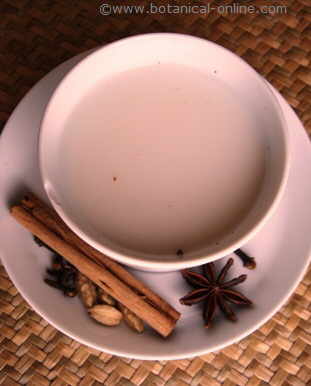
Photo of tea Chai.
This infusion is typical of India and is prepared with tea, cinnamon and a mixture of spices
Besides its medicinal uses, we have to emphasize other very important uses:
- Cinnamon as a spice: As a spice it is widely used in cooking pasta, cakes, jams, rice, meat, fruit and vegetable salads, fruits, baked and grilled. (See more information about “Cinnamon and spice”.)
- Cinnamon in the industry: The industry uses cinnamon for its antifungal and antibacterial properties. Become a part in the composition of many products related to hygiene of the mouth. (Toothpaste, mouthwash, etc)
- Cinnamon in pharmacy: essential oil of this plant is used in pharmacy in the composition of syrups for colds and catarrh and nasal sprays.
- Cinnamon in the food industry: The essential oil for food preservation and its wealth of aromas and flavor and smell of many preparations, including beverages such as colas, gum, or many alcoholic beverages.
- Cinnammon in the perfume industry: Its rich fragrance makes it very suitable in the perfume industry, being used in the manufacture of perfumes, soaps, shampoos, etc.
- As a medicinal plant
Other species of cinnamomun
- Camphor (Cinnamomun camphora ) In the same genus, but with a very different name, the camphor tree comes from tropical Asia. It is a plant that can reach 30 m in height. From the bark of this tree camphor is obtained, a resin that is used in medicine, perfume production. In the chemical industry is used as an insect repellent, especially for moths and the plastics industry.
In medicine, it is mainly used as a diaphoretic, stimulant, carminative, digestive, sedative, antiseptic, antirheumatic, vulnerary and vermifuge.
- Cinnamon from China or Cassia (Cinnamomum aromaticum Cinnamomum cassia Blume =) comes from China and Indonesia. It is a tree up 15 m high and with very distinctive red bark. It is the species most commonly used in America as opposed to the Ceylon cinnamon that is more used in Europe. Its properties are similar to this, especially in regard to its digestive properties and its antiseptic properties for external use.
In Chinese traditional medicine it is used more often than true cinnamon. (See more information about this plant in the list above)
In addition to cinnamon from Ceylon (Sri Lanka) and from China, we should highlight other cinnamon that can be used in most cases with properties similar to these. Chemically the main difference is that they contain less eugenol than the cinnamon studied in this article:
- Indonessian cinnamon, Korintje, Java cinnamon, Padang cassia, Batavia cassia (Cinnamomum burmannii (Nees & T. Nees) Blume): More economical and tasting more bitter than cinnamon, it is the most widely used in Southeast Asian countries. The quality depends on whether it is extracted from the trunk or branches of the tree, and the size of the cut piece.
- Laurel bobo or Laurel avispillo: (Cinnamomum elongatum (Nees) Kosterm.): Native of the Caribbean islands.
- Indian bay leaf (Cinnamomum tamala (Buch.Ham.) T. Nees & Eberm.): The leaves, known as tamalapatra or tvakpatra, are used in the elaboration of mixtures of spices (Garam masala). It is commonly known as :Indian bay leaf, tejpat, tejapatta, Malabar leaf, Indian bark, Indian cassi or malabathrum
![]() More information on cinnamon
More information on cinnamon

